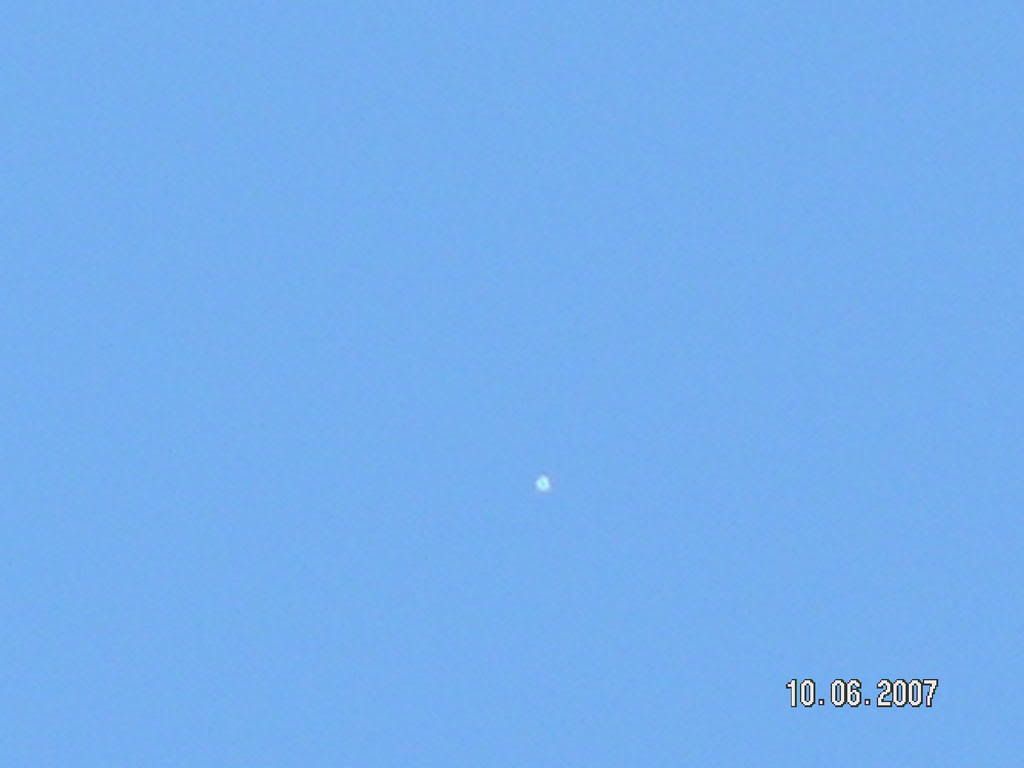Page 1 of 1
Bright Planets, Crescent Moon (APOD 11 Oct 2007)
Posted: Thu Oct 11, 2007 6:13 am
by Case
Why would Venus have 8 (main) sparks?

Posted: Thu Oct 11, 2007 1:46 pm
by NoelC
Because of Venus' high brightness and the fact that it's very small (virtually a pinpoint at this focal length), an optical effect called diffraction has become visible; basically passing light is scattered by the straight edges of the 8-vaned aperture in Mr. Ouellet's lens. These would be more accurately be called "diffraction spikes".
There's also diffraction around the sunlit portion of the moon quite visible in this image, though since the moon is large it comes off more as flare than spikes.
-Noel
Posted: Thu Oct 11, 2007 5:10 pm
by BMAONE23
Relative brightness has much to do with it. In this daytime image of Venus, there are no spikes because the surrounding sky is much brighter but Venus is still as bright as in the nighttime image.

Posted: Thu Oct 11, 2007 9:02 pm
by Case
NoelC wrote:...scattered by the straight edges of the 8-vaned aperture...
Thank you.
Posted: Fri Oct 12, 2007 1:18 am
by ChrisO
OK, I have to ask this simple question: why is Venus extra bright right now? For some God-unforsaken reason I was up before dawn, but that turned out to be quite a treat. I couldn't believe that the bright object is in fact Venus and not see caffeine-depleted hallucination.
BMAONE23: Marvelous image BTW, many thanks!
-Chris O
"Everything you know is wrong"
Posted: Fri Oct 12, 2007 5:20 am
by BMAONE23
Thanks Chris,
I just wish I had a better zoom level on my digital camera. I just have 10x optical and 4x digital. The digital zoom tends to distort distant images.
Posted: Fri Oct 12, 2007 2:31 pm
by Case
ChrisO wrote:why is Venus extra bright right now?
The brightness of Venus varies, and she's just past her maximum for this year.

Because the brightness scale in magnitudes is logarithmic, Venus was twice as bright last week than in January.
Posted: Fri Oct 12, 2007 4:36 pm
by auroradude
Not only is Venus near its greatest brilliancy but it is nearing its greatest western elongation (furthest angle from the sun). That takes place on the 28th of October.
It is nearly three hours ahead of the sun and 15 degrees north of it as well. This places it in a relatively dark sky before dawn so its brightness is even more noticable. This also makes it a little more favorable for northern hemisphere viewers.
Posted: Fri Oct 12, 2007 6:35 pm
by iamlucky13
BMAONE23 wrote:Thanks Chris,
I just wish I had a better zoom level on my digital camera. I just have 10x optical and 4x digital. The digital zoom tends to distort distant images.
FYI, digital zoom isn't really a zoom. It's just a crop and resize operation performed on-the-fly by the camera. Personally, I never use digital zoom. If I want a area enlarged relative to size of the frame, I do it myself after downloading the picture and have more control without adding any blurriness.
Posted: Fri Oct 12, 2007 9:25 pm
by BMAONE23
Thanks Lucky!
I guess I'll have to invest in a new copy of photoshop
Posted: Sat Oct 13, 2007 2:01 am
by geckzilla
Oi, Photoshop doesn't have any magical ability to sample up without being forced to interpolate. You might try this instead if all you want is a sharper guess.
http://www.ononesoftware.com/detail.php?prodLine_id=7
Any kind of sampling up should be avoided if at all possible, however. If you have a choice between a better camera or a better lens which will allow a real improvement in image quality, pick that over a software solution.
Posted: Sun Oct 14, 2007 3:50 pm
by NoelC
Genuine Fractals is a neat product.
Regarding Venus, I took a set of high magnification images of Venus a while back through my telescope when Venus was visible in the evening. The atmosphere was moving around quite a bit as the heat of the day was still quite present. To show the extent of the atmospheric distortion I created an animation from them.
Also, as it was fairly low in the sky, the atmosphere acted like a prism, dispersing the colors of the light as a spectrum. Venus is actually pretty much white.

Note that the above image is rotated 180 degrees. The sun was really below and to the right of the planet. I really need to shoot it again, early in the morning as Mr. Ouellet has.
-Noel


